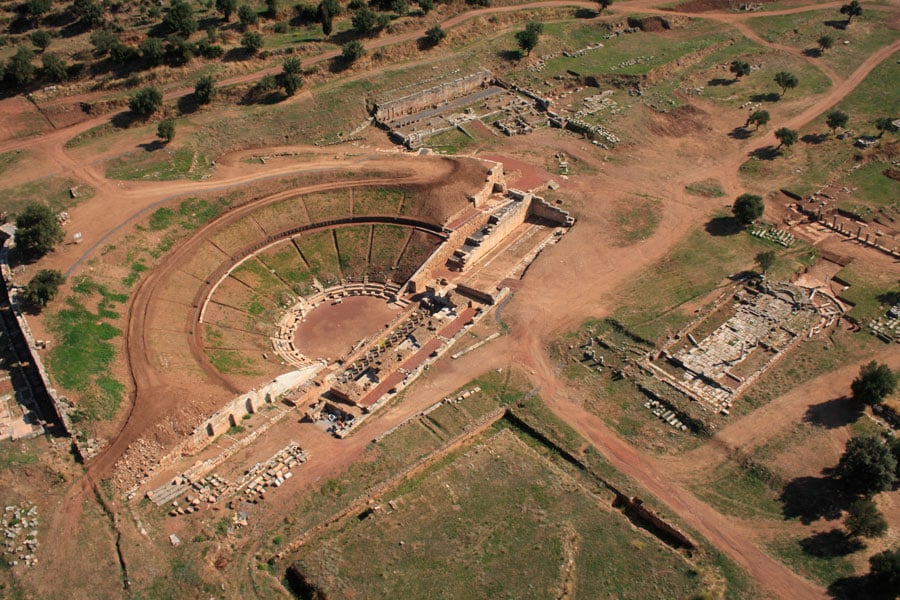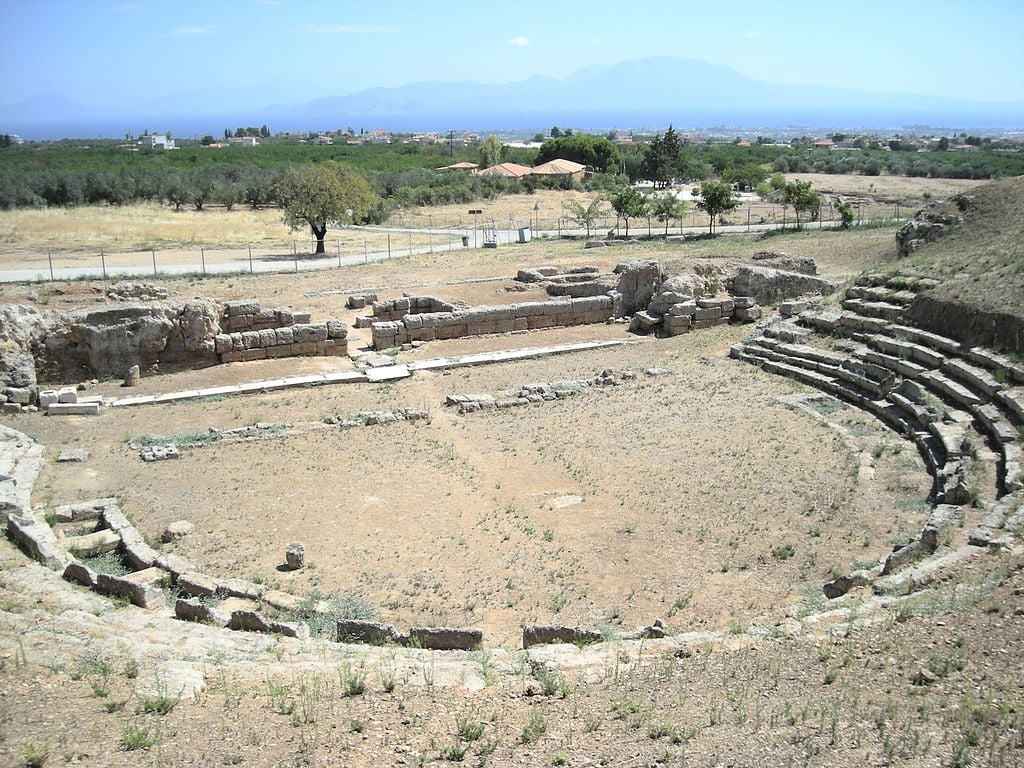
The ancient Greek theaters at Messene and Sicyon in the Peloponnese were centers for drama and culture in both ancient times and during the Roman period of Greek history.
The ancient Greek theater at Sicyon (present-day Kiato) was built between 303 and 251 BC, but was renovated and altered at least twice by the Romans.
The scene building was expanded in the first century, and the stage was altered in the late Roman period. With a seating area estimated at 122 meters (400 feet) wide and 58 meters (190 feet) deep, it is one of the largest theaters in the Peloponnese.
The present day ruins at Sicyon are a faint reminder of the Romanized theater the historian Pausanias visited in the second century AD.
The restoration effort to preserve Sicyon
However, in February of 2013, the monument underwent a restoration program so that it could be protected once and for all and could once more be recognized for the cultural landmark that it is.
The regional unit of Corinth and Sicyon donated 200,000 euros toward this ambitious effort. The Diazoma Association, a network of archaeologists, curators, and conservators along with Greek artists, intellectuals and local mayors, and regional administrations and citizens, donated 10,000 euros to the gigantic task.
The Diazoma group, whose mission is to create synergies in order to protect and promote ancient theaters, took the lead in the enhancement and restoration of the ancient site. Tasking themselves with reconnecting the Greek people with their ancient past through the wonders of their ancient theaters, they hope to restore and reopen many more such theaters all over the country.
In his day, the historian Pausanias recorded the scene at Sicyon thus: “On the stage of the theater built under the citadel is a statue of a man with a shield, who they say is Aratus, the son of Cleinias. After the theater is a temple of Dionysus.”

Today, the exposed remnants of the partially-excavated theater stand in mute testimony of its former grandeur. The American School of Classical Studies at Athens undertook the most major excavations there in modern times; however, their work is incomplete.
The outlines of the amphitheater are clearly visible, with several rows of stone seats, a horseshoe-shaped orchestra area showing evidence of drainage ditches or other depressions and remains of an ancient scene are still visible, as well.
The foundations of a proskenion stage, as well as the remains of stone proskenion access ramps, are there, along with two imposing arched passageways leading through the hill to the cavea.
Visitors to the site will surely note the picturesque view of the Corinthian Gulf just two kilometers away. Sadly, the “statue of Aratus,” as noted by Pausanias, has long since vanished, as have the columns and carved marble ornaments that once graced the theatre’s façade.
What remains, however, are the foundations of a late 4th century Hellenistic theater with evidence of successive Roman alterations to the skene and proskenion stage.

The koilon, or bowl-shaped seating area, is carved for the most part out of the bedrock in the side of a hill. Initial excavations in the late 19th century by the American School of Classical Studies under the successive directorships of M.L. D’Ooge, A.C. Merrim, and M.L. Earle, unearthed portions of the lower four rows of seats.
Successive excavations exposed portions of the lower nine rows and included a row of prohedriai benches (stone seats of honor with backrests) which borders the orchestra. The remainder of the koilon remains buried beneath several feet of earth.
The Theater itself is a two-story structure with a one-story forebuilding facing the orchestra, or proskenion, with a colonnade supporting a long, narrow stage. Stairs or ramps running parallel to the parodoi, like others at Eretria and Epidaurus, at the far ends of the stage provided access to the stage from the orchestra level.
Access from the rear was provided through large openings that pierced the second-story wall. These 3rd and 2nd century BC constructions would have made the theater resemble a two-story palatial house with a one-story terrace supported by a colonnade.
In total, the audience seating measures 122 meters (400 feet) wide by 58.41 meters (192 feet) deep. The number of seating rows is estimated at forty to sixty but no approximate seating capacity is known for sure.
The front row of seating consists of thirteen prohedriai, or the ancient version of VIP seats. Their wide benches have arms, as well as backs. The prohedriai at Sicyon are carved from the same native rock as most of the ordinary rows of seats. Like their counterparts in Athens, however, ornamental scroll work can still be observed on the benches’ exterior arms and bases.
A pair of vaulted passages on the east and west side of the koilon provided audience access. The 2.55-meter (8.4 feet) wide tunnels are important examples of true Greek arches.
The vaults at Sicyon predate Roman influence and are contemporary to the original construction of the theater, according to archaeologists.
The orchestra area at Sicyon has a diameter of 24.3 meters (about 80 feet). Composed of packed earth, it comprises somewhat more than half the circumference of a circle. A wide drainage channel surrounds the orchestra and separates it from the prohedriai in the first row. Stone slabs cover the channel in front of each stairway, acting as a bridge.
An elaborate network of subterranean channels extends from the center of the orchestra to the perimeter of the prohedriai and to the rear of the skene, and it is tempting to compare these covered tunnels to the underground passageways for actors at the Hellenistic theatres at Eretria, Corinth and Argos, archeologists say.
These passageways led to stairs, or “Charonian steps,” which allowed for the mysterious entrances of performers during plays. Some archaeologists have argued that the channels served performance purposes along with drainage needs; others contend that they are nothing more than large drains suitable for an orchestra with a clay floor and a coastal city which sometimes experiences heavy rains.
The excavations at Sicyon revealed a scene building 24.5 meters (80 feet) wide and 12.11 meters (40 feet) deep with ramps carved out of the bedrock on either side. These ruins represent both Greek and Roman constructions. The stage was about 3.3 meters (10.7 feet) high and 2.8 meters (9 feet) wide.
The ruins indicate Roman renovations in the 1st century BC and in the late Roman period. Initial alterations extended the scene building away from the audience and included a Doric portico at the rear. A late Roman renovation replaced the Hellenistic proskenion with a deeper Roman stage that extended forward to the edge of the koilon.
The Hellenistic proskenion wall was replaced with a Roman wall and had three openings: a double set of doors in the center flanked by two single doors. However, sadly, little of this wall remains.
Excavations at Sicyon by the American School of Classical Studies ran from 1886 to 1891, and the Archaeological Society at Athens conducted further excavations in 1920 and 1984. The 4th Ephorate of Prehistoric and Classical Archaeology is responsible for all city excavations, as well as those in the surrounding area. Movable objects which were found at the site are now housed in the onsite Sicyon museum, which reopened in 2007.
The Theater of Messene, Ancient Treasure of Peloponnese

For more than 600 years, the ancient theater of Messene was an important center for not only drama but events in the political sphere, as well. Great men of the past once strode its stage, including Philip V, the king of Macedonia, and the general of the Achaean League, Philopoemen from Megalopolis.
The theater was used for entertainment events and as a gathering place for political purposes. It was where Philip V, the king of Macedonia, and Aratus of Sicyon met in 214 BC one day after the uprising of the people and the slaughter of the city’s officials along with 200 wealthy citizens had taken place.
According to Livius, a great many citizens of Messene had gathered at the theater, demanding that general Philopoemen from Megalopolis be brought before them there in plain sight after being captured by the Messeneans in 183 BC.
After operating for six centuries, the theater was tragically abandoned. Characteristic of the apathy of the residents of the area regarding its fate during the Byzantine era, local people removed many of the seats and used them as building material for temples and houses.
After 1,700 years of neglect, and the silencing of the many voices which had once resounded there, the ancient theater of Messene finally re-opened its doors to the public in the summer of 2013.
The restored theater was reopened in August of that year with an opera gala, organized as part of the Greek Festival performed by the Athens State Orchestra and conducted by Giorgos Kouroupos. Soloists Dimitris Platanias and Tselia Kostea performed at the event, which was organized in cooperation with the “Diazoma” Association.
First Performance in One Thousand Years
The gala marked the very first time performances had been held there since 300 AD, when it closed.
During the 2013 gala, the theater accommodated 2,500 spectators. After the completion of restoration works, its capacity is estimated to reach 5,000 attendants, or exactly half the capacity it had in antiquity.
“When we first started the excavations, we found ourselves discouraged,” says Petros Themelis, head of the excavations. “The theater was practically non-existent; the only things left were some barrier walls and the olive groves surrounding it. Huge deposits of earth covered the orchestra and the koilon.”
The restoration of the ancient theater lasted ofr more than twenty years. With great effort, archaeologists managed to reunite the scattered stone slabs and put back more than 2,000 of these seats back into place.
Asked if the presence of spectators in this priceless ancient theater would be damaging, Themelis demurred. “The only damage is caused by women’s high heels,” the archaeologist replied. He stated that he believes the purpose of a theater is to be used rather than remain closed off to the public.
“The risk of damage comes through time—not people,” he explains.
Themelis’ vision is that the theater and ancient city host many public events going forward. He argues that if a monument isn’t going to be revived as a public venue, there is no point in excavating it.
“We want the theater to operate for events, schools, conferences. We want all areas of ancient Messene to operate in a multifaceted manner,” he notes. “We want the whole city to [come] alive, to be related to society and the institutions.”
The ancient Greek theater of Messene is located at the northwest of the archaeological site of Messene. Its first building phase is dated back to the 3rd century BC. The walls of the scene, the proscenium, and the orchestra were repaired during the 1st and 2nd century AD.
The high pointed posterns and the staircases mounting to the highest levels of the grand theater give the impression of a fortress. These elements, along with the fact that the retaining wall was visible and accessible from outside, render the theater of Messene unique in its kind and a precursor of the colossal theaters and amphitheaters of the Roman era.
See all the latest news from Greece and the world at Greekreporter.com. Contact our newsroom to report an update or send your story, photos and videos. Follow GR on Google News and subscribe here to our daily email!



